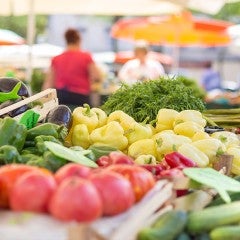The recent cancellation of a federal report measuring food insecurity means more work on the plates of nonprofits and researchers working to combat hunger in Houston.
With the Department of Agriculture announcing it will discontinue the Household Food Security Report, an annual look at rates of food insecurity across the country, local leaders in the field said collecting and sharing more information could serve as a substitute for the federal data.
Advocates and researchers routinely rely on food insecurity data to understand community needs, distribute resources and gauge the impact of food-related policies. Typically, a person classified as food-insecure has limited access to enough nutritious food for an active, healthy life at some point in a year.
“Without data, it’s difficult for organizations to know where to focus their efforts or how to measure progress,” said Sejal Mistry, a researcher at the Center for Community and Public Health at the Kinder Institute for Urban Research. “With the cancellation of the federal household food security reports, local data becomes even more essential.”
For nearly 30 years, the Census Bureau and Agriculture Department have collaborated to survey tens of thousands of people each year about their ability to afford and obtain food. The report provides an annual snapshot of national and state-level trends, though it doesn’t include data on food insecurity at the metropolitan or municipal level.
In a statement last month confirming the cancellation, the Trump administration’s Agriculture Department said “these redundant, costly, politicized, and extraneous studies do nothing more than fear monger.” The statement noted that “trends in the prevalence of food insecurity have remained virtually unchanged.” (The share of food-insecure households has hovered from 10% to 15% since the early 2000s.)
The survey’s supporters, however, argue it’s a key piece of data for understanding hunger, bringing attention to the issue and helping evaluate the impact of federal laws related to food, such as looming cuts to food stamps.
Seeking other sources
While the federal report is ending for now, other data points can still help paint the picture of food insecurity in Houston.
Houston Food Bank President and CEO Brian Greene, who leads the nation’s largest food bank by distribution, said his organization has long relied on other Census metrics, data from the national nonprofit Urban Institute and regional research to serve an 18-county area. Staff members use the data to help decide how many meals are needed, where to set up mobile pantries and what kinds of food to deliver.
“These sources give us actionable insight,” Greene said in a statement. “Even without the national survey, our strategy is grounded in evidence from our own community. While losing this data is not ideal, we have other strong data sources to inform the picture of food insecurity in our area.”
In August, the Kinder Institute released results from its new survey of food insecurity in Harris County, based on responses from about 5,200 people participating in the Greater Houston Community Panel.
The research snapshot showed about 18% of Harris County households reported “high food insecurity” and 21% reported “moderate food insecurity,” well above national averages. Black and Hispanic households and those earning under $35,000 a year were also disproportionately impacted.
Mistry, a co-author of the report, said the Kinder Institute conducted the analysis to better understand the local prevalence of food insecurity and identify the most-impacted communities. By highlighting areas with the greatest needs, local leaders can collaborate more effectively on targeting resources and developing solutions, she said.
“This report is meant to spark important — and sometimes uncomfortable — questions about why food insecurity persists in a city with so many resources, and what more we can do together to build a stronger, healthier Houston,” Mistry said.
Building better systems
While solid local data exists, Greene still sees opportunities for improvement through better data practices and collaboration with the food bank’s 1,600 nonprofit partners.
“Even as some national data tools fall away, these local (and) regional sources are strong and growing,” Greene said. “Houston Food Bank has capacity, expertise, and the civic will to lead in building data systems that reflect real community need.”
Mistry added that future food insecurity research in Houston could rely on multiple data points, including local surveys, food desert maps and usage of food assistance programs like the federal Supplemental Nutrition Assistance Program and Texas WIC. Researchers also could speak directly with food-insecure Houstonians to understand their needs, she said.
“There are many ways to research food insecurity, but at the end of the day, we need to meet people where they are and ask about their experiences,” Mistry said. “Listening to their stories about what makes it hard to find or afford healthy food helps us see more clearly who is affected and where support is needed.”



